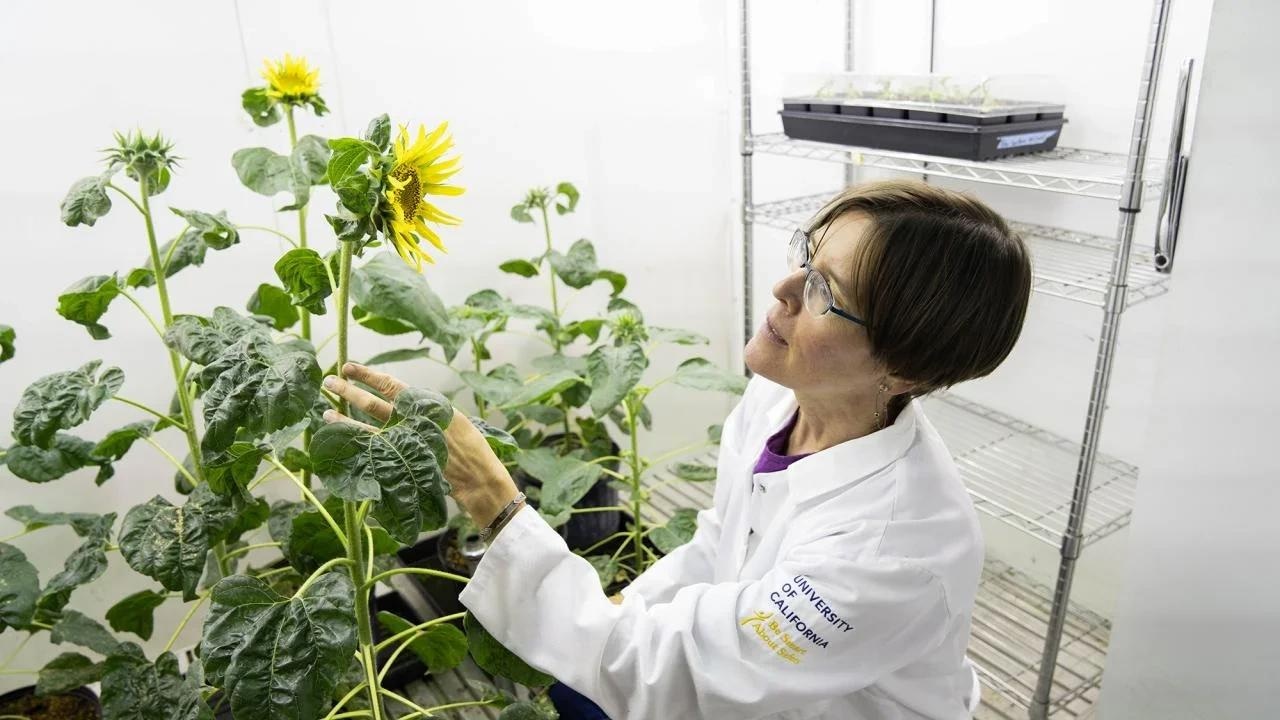Reviewed by Danielle Ellis, B.Sc.Nov 1 2023
Sunflowers are renowned for their ability to track the sun’s movement across the sky by turning their faces towards it.
 Plant biologist Stacey Harmer studies how sunflowers are able to follow the sun. Her new research shows that sunflowers respond to the sun through a previously unknown mechanism. Image Credit: Sasha Bakhter, University of California Davis College of Biological Sciences.
Plant biologist Stacey Harmer studies how sunflowers are able to follow the sun. Her new research shows that sunflowers respond to the sun through a previously unknown mechanism. Image Credit: Sasha Bakhter, University of California Davis College of Biological Sciences.
However, recent research conducted by plant biologists at the University of California, Davis, has unveiled a surprising revelation: sunflowers employ a unique and previously undiscovered mechanism to “observe” the sun and adjust their orientation accordingly.
The study was reported in the journal PLOS Biology on October 31, 2023.
This was a total surprise for us.”
Stacey Harmer, Study Senior Author and Professor, Plant Biology, University of California-Davis
The majority of plants exhibit phototropism, the capability to grow towards a source of light. Plant scientists previously presumed that sunflowers' heliotropism, their ability to track the sun, operated on a similar fundamental mechanism. This mechanism is typically controlled by a molecule known as phototropin, which responds to light in the blue part of the spectrum.
Sunflowers achieve their sun-tracking movement by strategically growing slightly more on the eastern side of their stems during the day, causing their heads to face west. At night, they adjust by promoting growth on the western side, thus swinging their heads back towards the east.
In the UC Davis College of Biological Sciences, Harmer’s research team has previously demonstrated how sunflowers employ their internal circadian clock to predict the sunrise and synchronize the blooming of their florets with the arrival of pollinating insects in the morning.
Growing Toward Light
In their latest investigation, Graduate Student Christopher Brooks, Postdoctoral researcher Hagatop Atamian, and Harmer examined the gene activity by observing sunflowers cultivated indoors within laboratory growth chambers and those flourishing outdoors in natural sunlight.
Indoors, sunflowers exhibited a direct growth toward the light source, leading to the activation of genes linked to phototropin. In contrast, sunflowers growing outdoors, which followed the sun’s movement, displayed a distinctly divergent gene expression pattern. Notably, there was no observable disparity in phototropin expression between different sides of the stem.
As of now, the research team has not yet pinpointed the specific genes responsible for heliotropism.
We seem to have ruled out the phototropin pathway, but we did not find a clear smoking gun.”
Stacey Harmer, Study Senior Author and Professor, Plant Biology, University of California-Davis
The obstruction of blue, ultraviolet, red, or far-red light using shade boxes yielded no impact on the heliotropism response. This indicates the likelihood of multiple pathways that respond to different light wavelengths while achieving the same objective. Future research will delve into the regulation of proteins in these plants.
Sunflowers display remarkable adaptability. When laboratory-grown plants were transferred to outdoor settings, they promptly commenced tracking the sun from the very first day, as noted by Harmer.
This behavioral change was accompanied by a notable surge in gene expression on the shaded side of the plant, although this response did not persist in subsequent days. This suggests the occurrence of some form of “rewiring” within the plants, as noted by Harmer.
In addition to unveiling novel pathways for light perception and growth in plants, this discovery holds significant relevance, as emphasized by Harmer.
Things that you define in a controlled environment like a growth chamber may not work out in the real world.”
Stacey Harmer, Study Senior Author and Professor, Plant Biology, University of California-Davis
Growing Sunflower Tracks the Sun
Growing Sunflower Tracks the Sun. Video Credit: University of California Davis.
Source:
Journal reference:
Brooks, C. J., et al. (2023) Multiple light signaling pathways control solar tracking in sunflowers. PLOS Biology. doi.org/10.1371/journal.pbio.3002344.